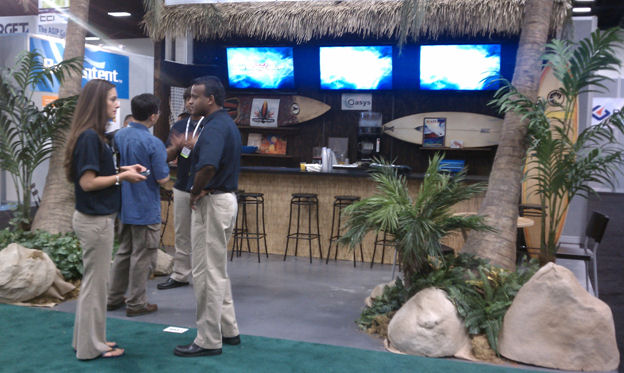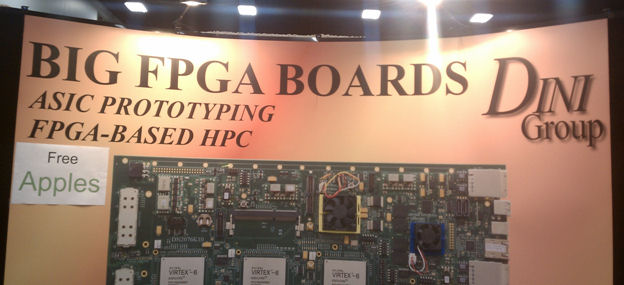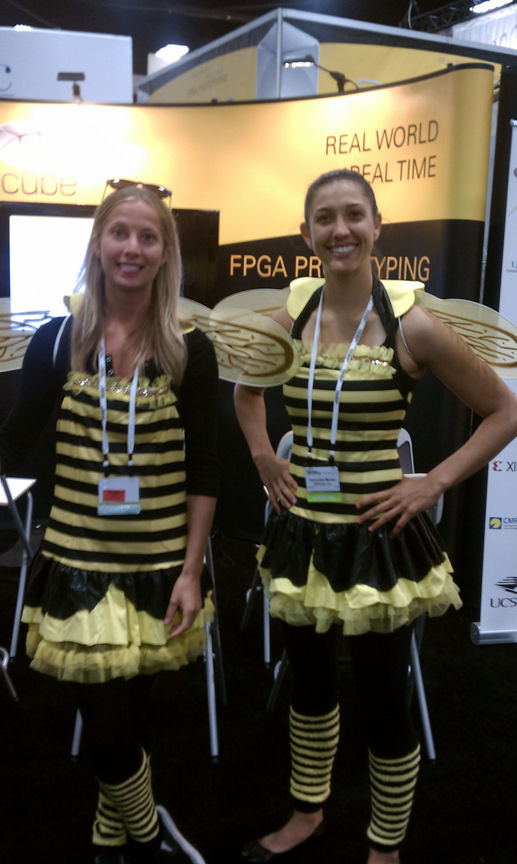I recently spent a day at the Design Automation Conference (DAC)—an event that has been a mainstay of the EDA industry for many years. One of the interesting things about the exhibit floor at DAC is that you always find a mixture of new companies—often with interesting new ideas—alongside established names that have been pillars of the EDA community for decades. It’s a bit of an adventure to walk the aisles and see what’s being offered.
Unfortunately, exploring a trade show exhibit floor can also be a frustrating exercise. One contributing frustration factor at this year’s DAC was that many companies don’t clearly state on their booth signage what it is they do. With about 200 exhibitor booths on the floor, attendees are unlikely to have the patience to stop at each booth just to find out whether the company’s offerings are relevant to the attendee’s interests. But that’s what was required at many DAC booths this year.
For example, Figure 1 shows an artistically designed booth at this year’s DAC. I have to admit, the tiki bar décor got my attention. (“Hmm....maybe they’re serving piña coladas!”) But signage on the booth was limited to the company’s name—one that was unfamiliar to me. Walking by such a booth, how can an attendee possibly determine whether spending time there will be worthwhile? Maybe the company is confident that all of its prospective customers already know about it and will seek out its booth. But that seems like a long-shot to me. And if everyone already knows about the company, why bother spending money on a booth at all?
Kudos to The DINI Group for showing how it should be done. As seen in Figure 2, from 100 feet away, if you can see this booth, you know what’s being offered. (The free apples are also a nice touch. One can only eat so many chocolate bars in a day.)
It seems pretty obvious, but apparently it bears repeating: If you’re going to spend the money to rent a booth space, transport your booth structure and your people, have the booth assembled, and have your people staff the booth, you should invest in a sign that succinctly describes your product or (even better) the problem your product solves. Let’s call this Trade Show Exhibitor Rule #1.
Another pitfall much in evidence on this year’s DAC exhibit floor was disengaged booth personnel. Yes, I realize that standing in a booth all day (or all week) can be extremely boring, particularly when visitor traffic is sparse. I’ve done it myself. Nevertheless, you’re there for a reason. If you’re staffing a booth, you should either be (1) talking with a prospective customer, or (2) watching for the next prospective customer, whom you'll then welcome with a friendly (but not too friendly) and engaging greeting. This means that you should not be reading your email, browsing a magazine, eating your lunch, or talking on your cell phone. Often I’ll approach a booth, see something interesting enough to capture my attention, and look around for a company representative. Being the reserved type, if all of the company representatives seem to be busy, I usually just move on. There are 199 other booths to check out, after all, and I only have a few hours. So, Trade Show Exhibitor Rule #2: When staffing a booth, pay attention to the customers—especially those just about to arrive.
Next we come to the inevitable “booth babes.” If you’re exhibiting at an electronics industry trade show, I’ll wager that attractive young women in suggestive costumes have no relevance whatsoever to your product. So, posting said young women in front of your booth, in addition to being sexist, is a bait-and-switch scam. (“What? You’re not a lingerie manufacturer? Oops—sorry—wrong booth!”) Sure, they catch my attention. But they don’t make me want to stop by your booth. On the contrary, they make me feel sleazy and want to move on. Trade Show Exhibitor Rule #3: No booth babes. Come, on folks, we’re a creative industry—we can do better. In figure 3, the creative thinkers at BEEcube prove it. (That’s “BEE-cube”—get it?)
I could go on and on, but it’s getting late, so I’ll wrap up with one last peeve: booth give-aways. You know, the T-shirts and other tchotchkesthat trade show exhibitors seem to feel compelled to offer as an inducement to stop by their booths. It would be interesting to know whether, in the history of industry trade shows, any exhibitor has ever attracted an actual new customer on the basis of a booth give-away. I suppose it’s possible, but it sure seems unlikely. Personally, I could do without the give-aways entirely. (Put that money into better signage instead!) But if you do feel compelled to offer give-aways, please know that I long ago accumulated a lifetime supply of t-shirts, pens, bouncy balls, and stuffed animals. If you’re going to provide give-aways, use some imagination and provide something unique and useful. The DINI Group’s free apples are a great example. Trade Show Exhibitor Rule #4: Forego give-aways unless you’ve got something special to give away.
Now that I’ve written this column, I realize it’s turned into a bit of a rant, and maybe it seems like I’m nit-picking. But I do think there’s a serious issue here. Exhibitors spend a pile of money on trade shows every year. It’s painful to see that money poorly spent—particularly when we know how hard it can be to get companies to spend money on other things that are clearly worthwhile.
What do you think? Are trade shows worthwhile? How should they be improved? I’d love to year from you! Post a comment or send me your feedback at http://www.BDTI.com/Contact.

Figure 1. Oasys booth at DAC 2011

Figure 2. DINI Group booth at DAC 2011

Figure 3. BEEcube Inc. “booth bees” at DAC 2011


Add new comment